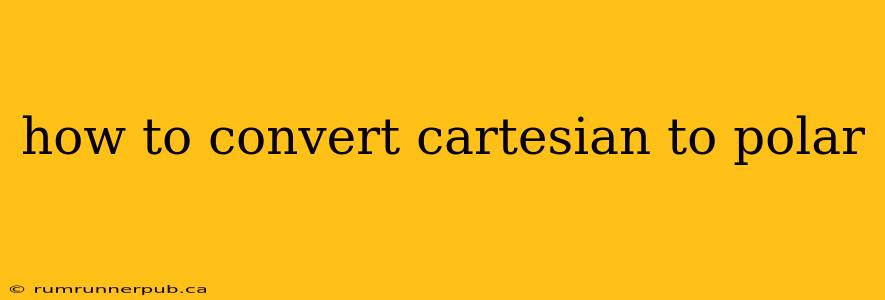Converting between Cartesian (rectangular) and polar coordinate systems is a fundamental concept in mathematics and numerous applications, from computer graphics to physics. This article will guide you through the process, drawing upon insights from Stack Overflow and adding practical examples and explanations.
Understanding the Coordinate Systems
Before diving into the conversion, let's briefly review each system:
-
Cartesian Coordinates: Represent a point using its horizontal (x) and vertical (y) distances from the origin (0,0). Think of a standard graph.
-
Polar Coordinates: Represent a point using its distance (r) from the origin (called the radius or radial distance) and the angle (θ, theta) it makes with the positive x-axis (measured counterclockwise).
The Conversion Formulas
The core of the conversion lies in these trigonometric relationships:
Cartesian to Polar:
r = √(x² + y²)This calculates the distance from the origin using the Pythagorean theorem.θ = arctan(y/x)This calculates the angle. However, be mindful of the quadrant! Thearctanfunction (oratanin many programming languages) typically only returns values between -π/2 and π/2. We need to adjust this based on the signs of x and y to get the correct angle in all four quadrants.
Polar to Cartesian:
x = r * cos(θ)y = r * sin(θ)
These formulas are straightforward applications of trigonometry in a right-angled triangle formed by the point, the origin, and the projection onto the x-axis.
Addressing Quadrant Ambiguity in arctan (Based on Stack Overflow Insights)
A common question on Stack Overflow revolves around handling the ambiguity of the arctan function. The atan2(y, x) function, available in many programming languages, elegantly solves this problem. (See numerous Stack Overflow posts discussing the limitations of atan and the advantages of atan2.)
Why atan2 is Superior:
atan2(y, x) considers the signs of both x and y, providing the correct angle in all four quadrants. This eliminates the need for manual quadrant checks which can be error-prone.
Example (Python):
import math
x = 1
y = 1
# Incorrect approach using atan
theta_incorrect = math.atan(y/x) # Returns pi/4 radians (45 degrees), which is correct for this quadrant.
print(f"Incorrect theta: {math.degrees(theta_incorrect)} degrees")
# Correct approach using atan2
theta_correct = math.atan2(y, x) # Returns pi/4 radians.
print(f"Correct theta using atan2: {math.degrees(theta_correct)} degrees")
x = -1
y = 1
# Incorrect approach using atan
theta_incorrect = math.atan(y/x) # Returns -pi/4 radians ( -45 degrees), which is wrong
print(f"Incorrect theta: {math.degrees(theta_incorrect)} degrees")
# Correct approach using atan2
theta_correct = math.atan2(y, x) # Returns 3pi/4 radians (135 degrees), correct this time
print(f"Correct theta using atan2: {math.degrees(theta_correct)} degrees")
r = math.sqrt(x**2 + y**2)
print(f"r: {r}")
Practical Applications
The conversion between Cartesian and polar coordinates finds applications in:
- Robotics: Describing robot arm positions and movements.
- Computer Graphics: Representing points and transformations in 2D and 3D spaces. Polar coordinates are often used for circular or spiral movements.
- Physics: Analyzing projectile motion, circular motion, or wave propagation.
- Signal Processing: Representing signals in the frequency domain.
Conclusion
Converting between Cartesian and polar coordinates is a crucial skill for anyone working with geometric calculations. While the core formulas are relatively simple, understanding the subtleties of arctan and leveraging the power of atan2 is key to accurate and robust implementations. Remember to always consider the context of your application and the advantages that the atan2 function provides for resolving quadrant ambiguities. This article, enriched with insights from Stack Overflow and practical examples, should provide you with a solid foundation to work with both coordinate systems effectively.
